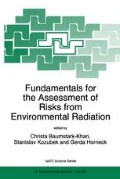Abstract
Fluorescence in situ hybridisation was used to determine the efficiency of the induction of aberrations in chromosomes 1, 2 and Y of human lymphocytes by y-rays, fast neutrons of mean energy of 7 MeV and accelerated nitrogen ions. The frequency and the spectrum of aberration types induced by these three types of radiation were different. Nitrogen ions induced the highest number of aberrations. The most frequent were chromosome fragments followed by centric rings. Neutrons and y-rays induced most frequently translocations followed by dicentric chromosomes. Efficiency of neutrons in the induction of aberrations was higher in comparison with y-rays.
Induction of aberrations by both y-rays and fast neutrons in Y chromosome was much less effective in comparison with chromosome 1. The low efficiency of these types of radiation in the induction of aberrations in Y chromosome is probably related to the lower content of DNA in this chromosome and to its higher content of hetero-chromatin.
Access this chapter
Tax calculation will be finalised at checkout
Purchases are for personal use only
Preview
Unable to display preview. Download preview PDF.
References
Natarajan, A.T. and Obe, G. (1978) Molecular mechanisms involved in the production of chromosomal aberrations. I. Utilisation of Neurospora endonuclease for the study of aberration production in G2 stage of the cell cycle, Mutai. Res. 52 137–149.
Natarajan, AT., Darroudi, F., Mullenders, L.H.F., and Meijers, M. (1986) The nature and repair of DNA lesions that lead to chromosome aberrations induced by ionizing radiation, Mutat. Res. 160 231–236.
Schmid, E., Bauchinger, M., and Mergenthaler M. (1976) Analysis of the time relationship for the interaction of X-ray induced primary breaks in the formation of dicentric chromosomes, Int. J. Radial. Res. 30 339–346.
Bedford, J.S. and Cornforth, M.N. (1987) Relationship between the recovery from sublethal X-ray damage and the rejoining of chromosome breaks in normal human fibroblasts, Radiai Res. 11 406–423.
Ward, J.F. (1988) DNA damage produced by ionizing radiation in mammalian cells: Identities, mechanisms of formation and reparability, Prog. NucL Acid. Res. Mol. Biol. 35 95–125.
Pinkel, D., Straume, T., and Gray, J. (1986) Cytogenetic analysis using quantitative, high sensitivity, fluorescence hybridisation, Proc. Natl. Acad. Sci. USA 83 2934–2938.
Lichter, P., Cremer, T., Borden, J., Manuelidis, I., and Ward, D.C. (1988) Delineation of individual human chromosomes in metaphase and interphase cells by in situ suppression hybridisation using recombinant DNA libraries, Human Genet. 80 224–234.
Savage, J.R.K. (1975) Classification and relationships of induced chromosomal structural changes, J. Med. Genet. 12 103–122.
Kraft, G., Krämer, M., and Scholz, M. (1992) LET, track structure and models: a review. Rad. Environnz Biophys, 31 161–180.
Weber, K.J. and Flentje, M. (1993) Lethality of heavy ion-induced DNA double-strand breaks in mammalian cells, Int. J. Rad. Biol. 64 169–178.
Heilmann, J., Rink, H., Taucher-Scholz, G., and Kraft, G. (1993) DNA strand break induction and rejoining and cellular recovery in mammalian cells after heavy ion radiation, Rad. Res. 135 4655.
Prise, K.M. (1994) Use of radiation quality as a probe for DNA lesion complexity. Int. J. Rad. Biol. 65 43–48.
Prise, K.M, Folkard, M., Newman, H.C., and Michael, B.D. (1994) The effect of radiation quality on lesion complexity in cellular DNA. Int. J. Rad. Biol. 66 537–542.
Jenner,T.J., Belli, M., Goodhead, D.T., Ianzini, F., Simone, G., and Tabocchini, M.A. (1992) Direct comparison of biological effectiveness of protons and alpha-particles of the same LET. III. Initial yield of DNA double-strand breaks in V79 cells, Int. J. Rad. Biol. 61 631–637.
Mendelson, M.L., Mayall, B.H., Bogart, E., Moore D.H., and Perry, B.H. (1973) DNA content and DNA-based centromeric index of the 24 human chromosomes, Science 179 1126–1129.
Natarajan, A.T. and Ahnstrom, G. (1973) Induced chromosomal aberrations and heterochromatic.In: Modern Aspects of Cytogenetics: Constitutive Heterochromatin in Man. (R. A. Pfeifer ed.) Stuttgart, Schatauer, pp.215–223
Bedford, J.S. and Muhlman-Diaz, M. (1991) Damage selectivity in chromosomes In: Proceedings of the 9ht ICRR Congress, Vol II. (J.D. Chapman, W.C. Dewey and G.F. Whitmore eds.) N.Y. Academic pp. 212–217.
Vyas, R.X., Darroudi, F., and Natarajan, A.T. (1991) Radiation induced chromosomal breakage and rejoining in interphase-metaphase chromosomes of human lymphocytes, Mutat. Res. 249 2935.
Natarajan, A.T., Balajee, A.S., Boei, J.J.W.A., Chatterjee, S., Darroudi, F., Grigorova, M., Noditi, M., Oh, H.J., Slijepcevic, P., and Vermeulen, S. (1994) Recent developments in the assessment of chromosomal damage, Int. J. Rad. Biol. 66 615–623.
Author information
Authors and Affiliations
Editor information
Editors and Affiliations
Rights and permissions
Copyright information
© 1999 Springer Science+Business Media Dordrecht
About this chapter
Cite this chapter
Lukášová, E. et al. (1999). Aberrations Induced in Chromosome 1, 2 and Y of Human Lymphocytes by Three Types of Radiation of Different Let Value as Detected by Fish. In: Baumstark-Khan, C., Kozubek, S., Horneck, G. (eds) Fundamentals for the Assessment of Risks from Environmental Radiation. NATO Science Series, vol 55. Springer, Dordrecht. https://doi.org/10.1007/978-94-011-4585-5_26
Download citation
DOI: https://doi.org/10.1007/978-94-011-4585-5_26
Publisher Name: Springer, Dordrecht
Print ISBN: 978-0-7923-5668-4
Online ISBN: 978-94-011-4585-5
eBook Packages: Springer Book Archive

